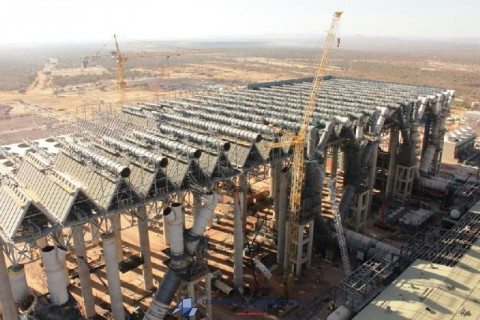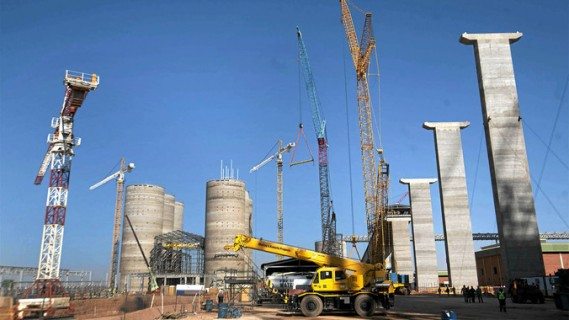Africa’s answer to power demands
One set of experts contend that even the most aggressive push to seek alternative energy sources to coal will not replace coal in the foreseeable future and with China’s demand rising, third world countries -Africa included- will not be far behind in tapping this vastly available resource.
Currently, Africa needs an additional 7000mw per year to fuel economic growth and sits on 35billion tons of recoverable coal reserves that would see it through for the next 122 years. For many this is more a blessing than a curse.
Several countries have taken the cue and are in the process of developing coal fired plants to meet demand while lowering the cost of electricity to build a competitive manufacturing base.
Opposition to coal
This news however has not been received without increasing opposition. The USA has said that it will stop funding new coal power plants except in rare circumstances tied to environmental conservations, and this position has since been taken up by the U.K., the Nordic countries, and the Netherlands. In Africa this is seen as unfair given that the USA still has the highest per capita consumption of coal while no viable alternatives are on the table and so several African governments have voiced their insistence on going through with their plans to develop coal resources.
When President Obama invited African heads of states to discuss business partnership possibilities in Washington last year’s at the first ever US-Africa Leadership Summit, many leaders said that coal was not to be left out as a strategy for powering Africa.
Tanzanian Minister of Power Sospeter Muhongo said “We should not be in the discussion of whether we should use coal or not…we are going to use our natural resources…We will start intensifying the utilization of coal.” Chinedu Nebo, Nigeria’s Minister of Power on his part said “Africa should be allowed to develop its coal potential. This is very critical. Africa is hugely in darkness.”
While the World Bank is bowing to pressure from environmental lobbyists to end funding of coal fired power plants, the African Development Bank (AFDB) has defended its position to continue financing coal fired plants. The Head of the Bank recently echoed the sentiments of most African governments when he said. “It is hypocritical for western governments who have funded their industrialisation using fossil fuels, providing their citizens with enough power, to say to African countries, ‘You cannot develop dams, you cannot develop coal, just rely on these very expensive renewables’,”
Ongoing coal power projects
South Africa is leading the way in leveraging its huge coal reserves to generate badly needed electricity. It is estimated that coal meets over 70% of the country’s energy needs and Medupi which is South Africa’s first power station to be built in 20 years will be the largest dry-cooled power station in the world. According to Eskom the local power utility company the six generating units will each produce 794 MW of electricity for a combined total of close to 4,764 MW when it is finally completed. The Kusile Power project which is also currently underway is also set to produce 4,800MW when complete.


Like Medupi Kusile will have 6 generating units. Cheap coal to fuel the power stations and the desperate need to meet demand for power in South Africa have necessitated the use of coal and the results are expected to have a positive impact on the country’s power supplies that have bee plagued by load shedding in the last decade.

Nigeria
In West Africa, a number of coal power plants are planned. Starting with Nigeria which will be counting on coal to produce 40,000MW of power by 2020 to feed its chronic shortfall. The Nigerian Electricity Regulatory Commission (NERC) has allowed Trombay Power Generation Limited to construct a 500MW plant in Gombe State. The Chairman of NERC, Dr. Sam Amadi said while issuing a license to the company in January this year that thorough examination had been carried out to ensure the project met strict standards in regard to feasibility and bankability.
The country is also planning to boost power production from another 500MW from a coal power plant to be constructed in Enugu State. The agreement for the coal power plant was signed in January this year between One Nation Energy Platform Ltd – the company undertaking the project – and the Federal government. In Phase two this project will generate a total of 1000MW. The country is hoping to generate 30% of its electricity from coal by 2015.
In Ghana where power demand stands at 2000mw with a deficit of 800mw, the Sunon Asogli gas power plant which currently produces 138MW will start to use coal to produce more power in its next phase. According to Togbe Afede feasibility studies on the project are underway to ensure the production of 700 megawatts from coal in the first phase to ensure consistent power supply.
Egypt approves coal use
Like most other African countries the failure to invest in power production facilities in the past has meant that supply has not kept up with demand. In Egypt which had placed a high reliance on gas power plants, failure to invest in new gas fields to supply power stations has meant that its 22,000MW power supply is fast becoming inadequate to the extent that early last year the government approved the importation of coal for generation of power by cement producers. This despite opposition form environmentalists. Following this Suez Cement, Egypt’s largest listed cement maker by market value is now going ahead with plans to spend US$84 million this year to equip two factories to run on coal to mitigate the countries energy shortfalls.
Another cement company Misr Beni Suef Cement will begin generating power for its cement plant by investing US$27.9m. It is only a matter of time before the country gets its first coal fired power stations supplying the grid. Already two coal-fired power plant projects have been announced, one by a consortium led by a private Abu Dhabi-based company Al Nowais, and another which will be developed by a JV of Egypt’s Orascom Construction and Abu Dhabi’s International Petroleum Investment Co. Orascom will construct a US$3bn coal power plant on the Red Sea coast.
Kenya is also set to enter into coal powered plants. Construction of the Lamu coal power plant is set to begin this October according to an announcement in February by Amu Power, a joint venture between Centum and Gulf Energy. Amu has said that the 981.5MW power project will need 870 acres of land where the plant will be set up and that they were waiting to be granted the land.
Amu will have the mandate to operate and own the development for 25 years. The government is hoping to get power from the plant to support heavy industries and the plant will be relying on coal imported from South Africa until Kenya starts sourcing coal from Kitui’s Mui Basin.
Lack of adequate power in Africa is also pushing investors in other sectors to invest in coal power generation for their operations. Dangote cement, will be investing in construction of Mbinga coal mine and power plant in the southwest of Tanzania to supply power for its Mtwara Cement plant. Dangote Cement will be counting on the demand of construction materials among them cement, to produce 3MT annually from the Tanzania-based plant. Although the cost of the coal plant ha not been disclosed, it will produce 75MW.
Kenya’s National Cement company is also planning on constructing a 15MW coal-fired power plant that would cost them US$19m in order to power their operations on planned limestone mining and clinker manufacturing factories at the location. The company will be counting on the plant to cut down operation costs while expecting to use 63,360t of coal per year. “The cost of procuring electricity from Kenya Power is twice as much when compared with the cost of generating power using coal,” said National Cement. Kenya is still struggling to provide cheap power, with many manufacturers decrying of high electricity costs.
The Global Commission on the Climate and Economy in its September report on global use of coal called for middle-income countries to start retiring existing coal power plants by 2025 and developed/high income nations to “accelerate the retirement of their existing plants” indicating that coal as a source for energy may not be the future. The stark reality however is that Africa needs power and the cheapest source available is coal.

While clean coal technologies have been mooted, the extent of how clean this can be is debatable. While western governments intend to withhold funding savvy business investors with less qualms concerning the environment are keenly snapping up opportunities to invest in coal plants across the continent as governments open up the sector to private investors.

